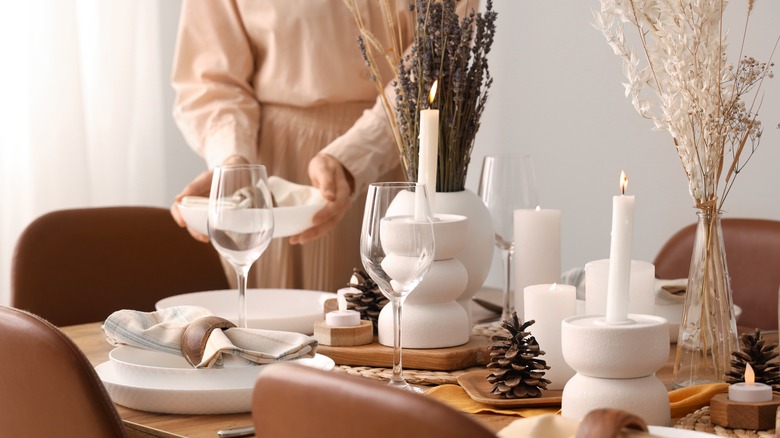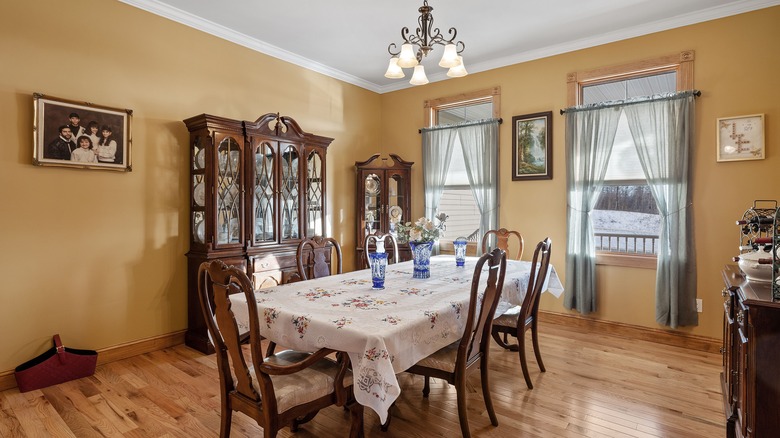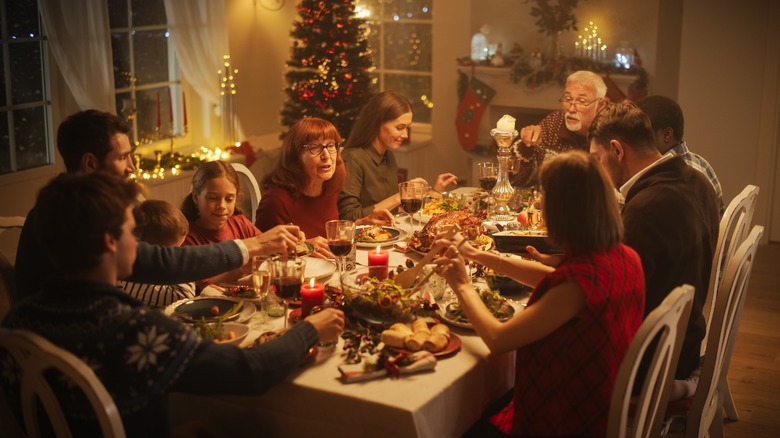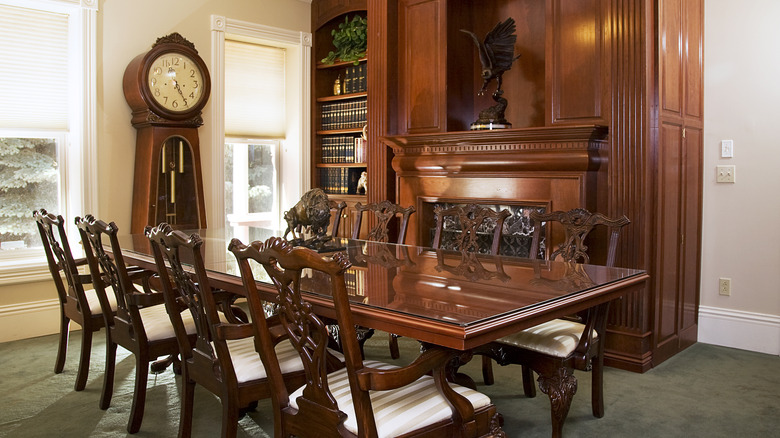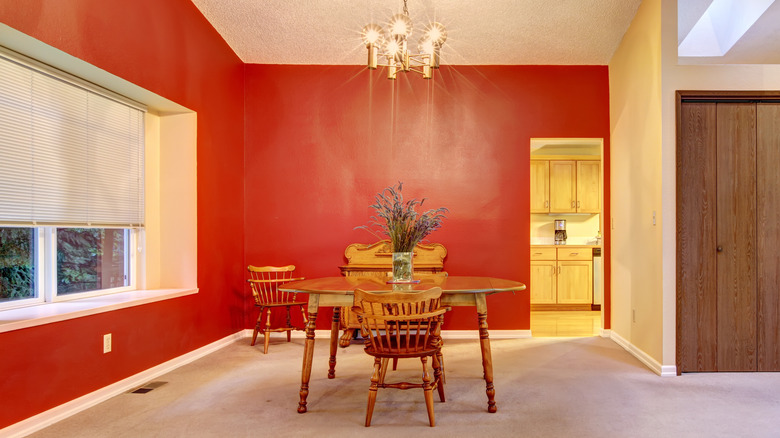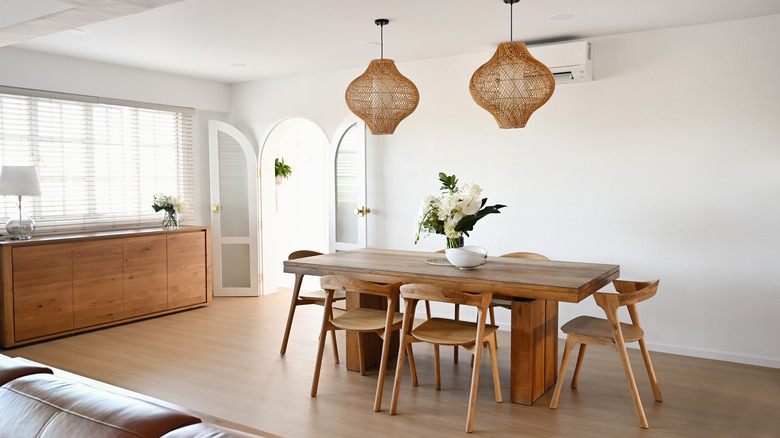5 Once-Popular Dining Room Trends That Are Making Your Home Look Dated
Are formal dining rooms a thing of the past? No, they're just evolving. Like a menu that changes with the season, dining rooms are changing with the times. Where they were traditionally decorated and used only for special occasions, they've become extensions of the kitchen in the still-hot open-concept style, seen mostly in newly constructed or renovated homes. For many, that means their purpose as a space has taken on new uses, especially since the pandemic. And their look has changed as well, thanks to loosened ideas of what's appropriate and what's not for decor. Yet, you still may be holding on to interior design rules of the past. As a result, those once-popular trends may be making your home look dated.
Making a statement with your dining room may come down to simple switches such as bringing in more casual furniture, reimagining the purpose of the space, removing big wood pieces, changing the colors, or hanging art. Let's look at dining trends then — formality, one purpose, too much wood furniture, traditional colors, and blank walls — and what you can and should do instead.
Formality
A dining room at the ready exclusively for special sit-down meals, usually at the holidays, often looks too formal, if not severe or sad for its lack of daily use. There's probably a large rectangular table in the middle of the room, a tablecloth and tired centerpiece atop, and multiple chairs — usually uncomfortable, perhaps with cushions covered in behind-the-times fabric. Hutches stand nearby, with plates and platters collecting dust, and outdated light fixtures shine too much light (or too little) from the ceiling, either hung too high or low. There might be no rug or a rug that's too small, both design choices of yesteryear.
Today, the dining room has become an increasingly popular spot for comfy, soft upholstered seating, including modern and cushy wingback and swivel chairs and relaxed benches and banquettes. Tables can be circular for more intimate dinnertime conversation by candlelight, and console tables are used for food instead of the usually overcrowded tabletop. Updates like these will likely fill up the calendar with everyday meals.
One purpose
The dining room also suffers from having one purpose — eating. Nowadays, many work or go to school on hybrid or fully remote schedules and are home more often. For this reason, dining rooms often function as a catchall for household activity. A place to do homework. A grown-up gathering place for cocktails. A makeshift office. A library.
The dining table can stay, but consider bringing it closer to a window to take advantage of natural light for reading and working. Doing so also creates a better pathway through the space, encouraging foot traffic. Another way to update the space is by creating vignettes around the room with seating and small tables. The end result is what some are dubbing the dining room/conversation area. With enough square footage, it's also not unusual to find a dining room combined with a living room. And in a move to completely upend the concept of a dining room, there are console tables that open up into a full table, allowing them to be transformed only when you want to use the area to eat.
Lots of wood furniture
It's common to outfit a dining room with huge pieces of furniture in addition to the table, which may be large enough to seat a dozen people or more. There's usually a China cabinet, sideboard, and all those chairs. And most of the time everything is wood, and the pieces might be matchy-matchy if they're part of a set. Placed on what is likely a wood floor, and it's just too much brown.
Break up the darkness with large area rugs in light colors and delicate patterns, wallpaper with contemporary or bold designs (consider covering the ceiling!), up-to-date lighting for brightness, upholstered chairs in fair tones, and furniture and accent pieces made of materials such as metal, glass, and stone. If you love your wood pieces, which may have been given as gifts from parents and other relatives and have sentimental value, consider freshening them up with paint in a modern color and either upgrading the hardware or painting it in a swanky gold.
Traditional colors
Hunter green, yellow, red, and brown are popular color choices in dining rooms of past as is out-of-fashion wallpaper. Decorators recommend updating the palette one of three ways. Brightening walls with a chic, vibrant color will instantly update the room. You can color drench the space, the painting trend that can boost the tranquility of your room by using that one color for walls, trim, and other details. The color can be bright and cheerful or dark and moody, and you can create texture by mixing flat and gloss surfaces.
Another way to update a dining room is by creating the very on-trend neutral color palette that blends browns and blacks with grays, beiges, and creams. Plants, throw blankets, and natural materials work well with the color scheme. Finally, you can go for the maximalist look, combining all kinds of colors that aren't necessarily considered pairs but combine for a youthful and edgy look.
Blank walls
Outdated dining rooms often contain blank walls. Sometimes that's a function of having very large walls in the room and being afraid to commit to filling them. Don't be scared: Display art. It's yet another way to bring in color. Create a mini gallery by making a big statement with oversized pieces or creating vignettes with smaller works. Another trend that's crept into the dining room is the gallery wall, which infuses the area with unique personality.
Don't forget that frames also come in colors, and that these can be all in the same hue or combined for visual interest. If there's a mantle, lean paintings against the wall for another 21st-century look. Refresh the space by occasionally switching out the art for impromptu home exhibitions. Similarly, you can hang floating shelves to show off your works. With some skill, you could even paint a floor-to-ceiling mural or draw on every square inch of the walls.
